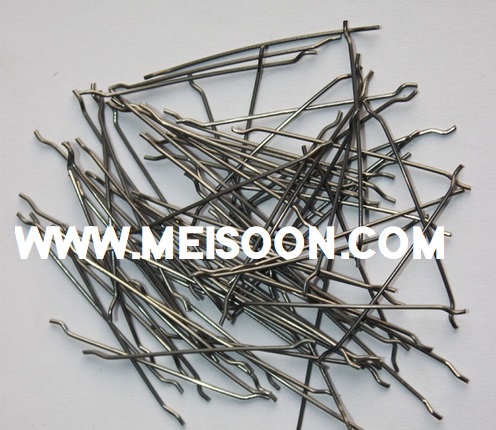|
Base Resin : steel Fiber Length : 30,50 mm Specific Gravity : 7.8 Tensile Strength : (1100 MPa )
|
STEEL FIBER
PRODUCT DESCRIPTION: The Steel Fibers are made of cold drawn steel wire with a low content of carbon. The Steel fiber provides a very good reinforcement of concrete. Extensive testing has confirmed that the undulated shape is a main factor leading to optimal anchorage within the concrete matrix and inherent control over shrinkage stresses. When choosing the correct steel fiber for your project, with knowledge of its behavior, having a strict control of its matrix, you obtain a steel fiber reinforced concrete with maximum:
|
||||||
|
Technical properties: The corrugated steel fiber can be used with the following parameters:
Our packaging solutions include paper bags of 20 kgs and cardboard boxes of 20 and 6.25 kgs, ready to be sent to your location at any moment, both by sea and by land.
Hook-end steel fiber
The steel fibers are made of cold drawn steel wire with a low content of carbon. Depending on the construction project, steel-fibers are manufactured in different types:
Though one of its main fields of usage is on-ground floors, it is also included in a wide range of construction parts : beams, pillars, foundations, tracks (airplane) or alone or with hand-tied rebars.
Applications of Steel Fibers
Fiber Reinforced Concrete (FRC) is one of the fastest growing segments in the concrete industry as more and more engineers, architects, owners and concrete contractors are turning to the use of fibers to supply their reinforcing needs in their concrete applications. The application of steel fibers is multiple. Depending on the needs of the project, they can be used with concrete in industrial floors, in construction of a vault, with incombustible concrete, with sprayed concrete and construction of residential buildings.
Potential projects suited to the use of fiber reinforced concrete are listed below: Residential: including driveways, sidewalks, pool construction with shotcrete, basements, colored concrete, foundations, drainage, etc. This method of reinforcement that dates back nearly 25 years, has expanded its use.
This method of reinforcement, whose beginning goes back nearly 25 years ago, has expanded its use. In Europe more than 50% of industrial floors are made with reinforced steel fibers. When we talk about industrial floors we refer to bearing concrete slabs in the production halls, the rack and conventional warehouses, in shopping malls, garages but also floors in outside surfaces like parking lots, truck or containers terminals in the logistics centers, gas stations or bus stops. Their thickness is usually ranging between 10 and 20cm, depending on the structural analysis. The addition of steel fibers can significantly increase the carrying capacity of concrete slabs, prevent the formation of cracks in the concrete curing stage and reduce stretching and shrinkage of hardened concrete due to temperature changes, increase its resistance to pressure and prolong the time usability of the concrete floor.
Highways / Roadways / Bridges:
Ports and Airports:
Waterways:
Mining and Tunneling: Precast segments and shotcrete, which may include
Reinforcement is added to shotcrete in order to give some pseudo-ductility as well as post-crack load-bearing capacity, especially in high deformation applications, such as those encountered in the mining Industry. Welded wire mesh has been used to reinforce shotcrete, but stiffness compatibility and placement difficulties has meant that a continuous metallic reinforcement was dropped in favour of discreet fibres that cross incipient cracks and add toughness and ductility.
Precast Concrete and Products:
|

